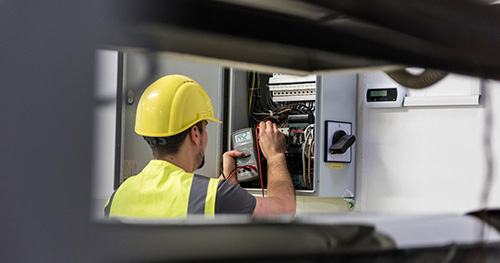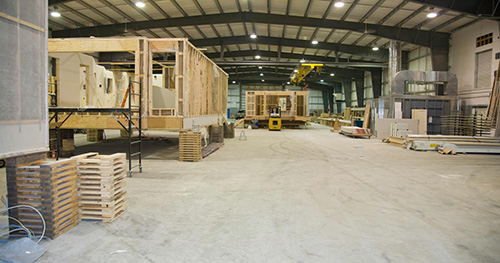 With the number of construction projects dwindling as a result of the pandemic, many companies are reimagining their business models to secure their future.
With the number of construction projects dwindling as a result of the pandemic, many companies are reimagining their business models to secure their future.
While how to increase productivity remains one of the major hurdles that the industry needs to overcome, construction and engineering companies must also look to servitization to attract new business. Even if it may appear to some as a question of identity, the provision of service will in reality be a question of survival for many businesses.
Even though the outlook is harsh, there is evidence that many companies are using the current lull to arm themselves with tools that will enable them to hit the ground running when the tide turns. In fact, a recent IFS study revealed that70 percent of businesses have increased or maintained digital transformation spend, despite the Covid-19 pandemic。在工程,建筑和基础设施领域,this figure is more than 75 percent.
Given the unpredictability of 2020, we are facing a new year whose challenges and opportunities are equally difficult to pin down. Despite the uncertainties, however, I have summarized a few trends that I believe will color 2021 and beyond:
Service turns cornerstone as builders approach total asset lifecycle responsibility

As a result of the disruptions of 2020, the construction industry is intensifying its focus on securing stable and robust revenue streams. This has led many companies to transform themselves from traditional construction companies to asset lifecycle service providers, able to provide through-life service, facilities management, and maintenance to their clients.
The upshot is a strengthened emphasis on total lifecycle cost rather than the traditional, one-and-done build cost. One of the major implications is the profound shift in focus among the companies building the assets. As they will be increasingly expected to assume cradle-to-grave service responsibility for each asset they build, they will need to focus on asset quality, longevity, and ease of maintenance. Put more provocatively, now that the asset is the construction company’s problem, it will need to be designed for quick and easy repair and maintenance.
As customers are more and more interested in buying outcomes rather than brick-and-mortar assets—for example, hospital beds rather than the building that houses them—construction companies will need to get used to providing an all-encompassing service offering.
A majority of stakeholders in the construction and engineering space are still doing business through two separate contracts—one to build and one for service. In 2021, however, I predict that we will see a decisive increase in the number of construction companies transitioning to a single contract that spans the entire lifecycle of the asset while regulating its output or availability.
The effect on companies’ business models will be profound as they will need to extend their planning horizons significantly to ensure long-term profitability. Even if they have competent staff to attempt this transformation, it is likely many construction companies will initially struggle to establish best-practice in service processes that will ensure delivery of new-to-them concepts such as customer engagement, service-level agreements (SLAs), and field service scheduling and optimization. One of the ways companies will solve this is to look at enterprise software designed to power the transformational journey from construction-only to through-life service provision.
异地建设drives need to standardize materials and processes

异地建设, also known asprefabrication, is a trend that has been gaining momentum across the industry. Whereas construction companies used to build a house using materials shipped to the site, many companies are today moving the actual construction to factory-like, indoor environments where tradespeople and contractors build components or modules that are shipped to and assembled on the building site. One of a vast number of examples of this trend is leadingengineering firm Babcock, who delivered prefabricated components to the Heathrow Terminal 5 project.
As the construction companies are tasked to manage increasingly complex logistics for each build, we will see a significant uptick in companies focusing on implementing supply chain management best practices. The vast majority of traditional construction companies will admit to having very little experience in working with things like parts numbers and inventory. The supply chain-centric work processes of a company like Amazon will not reflect the current reality of their businesses. Yet, this is thevocabularythey will need to learn (very quickly) in order to effectively and profitably manage the logistics challenge of getting hundreds or even thousands of prefabricated components to one or more construction sites—at the right time and in the right order.
I predict the construction industry will see accelerated investments in business software capable of imposing order on a supply chain-driven transformation that would otherwise spin rapidly out of control. Companies will increasingly turn to a manufacturing ethos as they get used to the idea of building standardized components with serialized part numbers that can be used in multiple projects, as opposed to costly, customized solutions.
In other words, 2021 will be the year when the inexorable march of offsite construction compels traditional construction companies to evolve and get to grip with the urgent need for standardization, both in terms of materials and work processes.
5D BIM comes of age as early movers eye 6D

By now, most people with an interest in the construction and engineering sector know whatBuilding Information Modeling (BIM) is and what its major benefits are。As a standalone technology for three-dimensional design, it has had a huge impact on how complex assets are being developed and built. Many industry stakeholders are currently talking about 4D BIM, which also takes the time and scheduling aspect into account, basically giving companies a video simulation of how and in what order an asset should be constructed.
What is not a very mature concept, however, is thecombination of BIM with enterprise resource planning (ERP) software, which is arguably where most crucial business data is stored. This lack of sophistication is odd, given the enormous potential in connecting the two. What I am referring to here is what is being hailed as 5D BIM.
With the fifth dimension being money, I predict that the challenges of 2020 will provide added incentive for companies looking to bridge the gap between BIM and ERP. The question an increasing number of construction companies will ask is how to take a BIM model and turn it into a cost estimate and then track the actual costs back to the BIM objects.
今天,要求公司竞标BIM模型,这是一个繁琐的过程,通常涉及无数的手动计算和测量。随着5D BIM脱颖而出,我预测,在2021年,建筑公司将开始要求自动化工具将BIM型号直接传输到其ERP软件的估计模块中。公司将期望标准集成能够在不同系统之间自由流动。需要的是集成,使投标团队按组件类型对数据进行分类和构建数据,将它们分成工作包,并自动为每个软件包定价。
Early-moving companies that are already implementing or trialing 5D BIM/ERP integrations will use their head start to investigate the sixth dimension of BIM: maintenance. At this stage of the maturity cycle, the visualization element of BIM takes a subordinate role to the free flow of information throughout the lifecycle of the asset—from design to build to maintenance. While still a few years out, I predict a rapid progression to 5D and 6D BIM.
Onwards and upwards
Even under ideal market conditions, construction is a demanding industry in which complex networks of projects and project delivery must be navigated effectively. I remain convinced that one of the best ways toensure business value and resilienceis the long-term investment in sensible technology that is fit for purpose.
For all its unpredictability, I believe that 2021 will be a year of opportunity in the construction, engineering and infrastructure sectors. But just as luck favors the bold, I also believe that capitalizing on these opportunities will require strategic fortitude and a clear vision of how servitization and technology could and should coalesce into new and more intelligent ways of working.


向本文发表评论
Report Abusive Comment